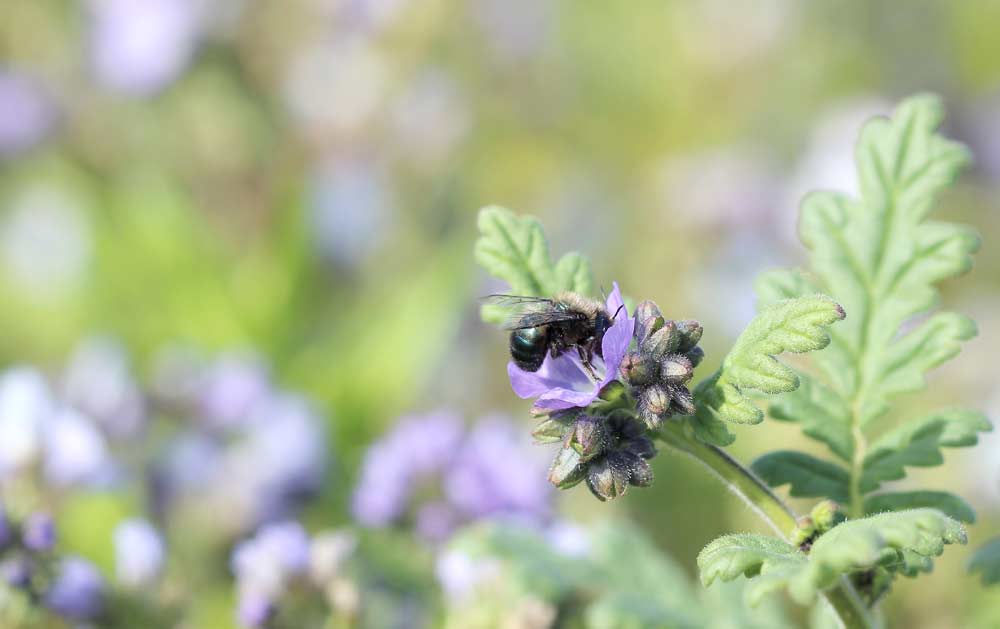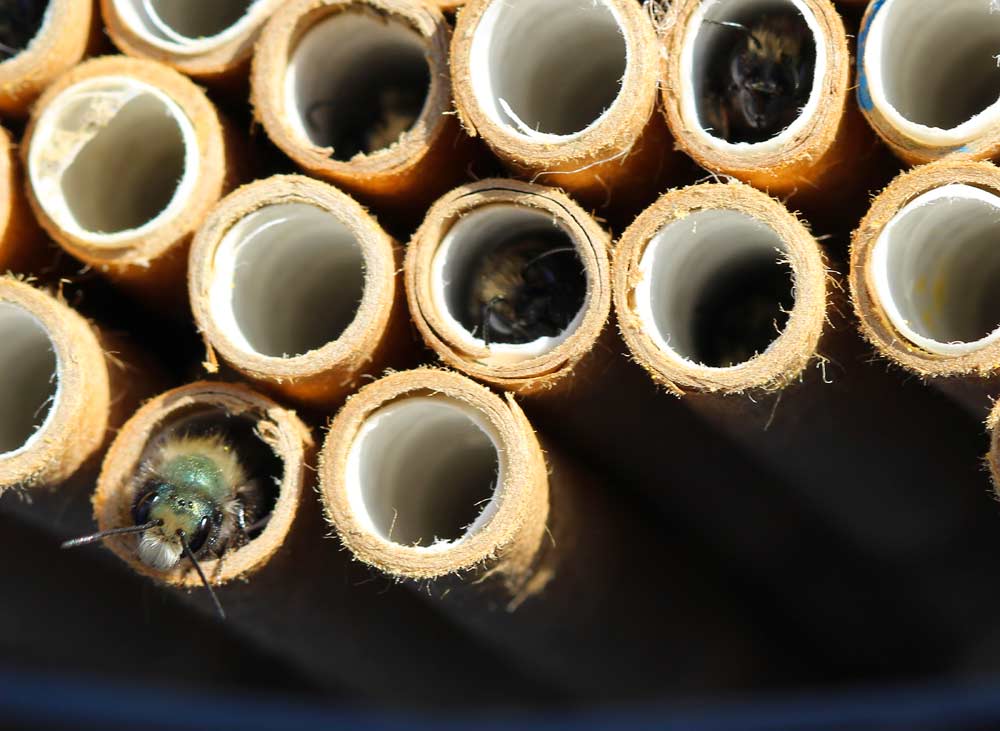
A blue orchard bee flies over a cover crop in an orchard. (Photo courtesy of Natalie Boyle/U.S. Department of Agriculture)
Tree fruit growers have long relied on managed honeybee colonies to pollinate crops, but researchers in Utah are wondering if there’s another bee that might better do the job.
The U.S. Department of Agriculture’s Pollinating Insect Research Unit in Logan, Utah, is researching the feasibility of blue orchard bees (Osmia lignaria) to pollinate some tree fruit crops.
The bees already are being employed in almond production in California, and research on their use in tart cherries showed promise the past two years. Now, researchers are aiming to expand their efforts to Washington sweet cherries and pears, two crops for which pollination can be a struggle.
Generally, honeybees are averse to foraging in pears, because the blossoms offer nectar that is low in sugar relative to most flowering plants, said Natalie Boyle, a research entomologist and postdoctoral researcher at the bee lab, which is housed at the USDA’s Agricultural Research Service site in Logan.
Sweet cherries, meanwhile, bloom early in the spring, when cooler, wetter weather may not favor honeybee foraging. In addition, the commercially grown varieties for both crops also require effective cross-pollination with co-blooming pollinizer varieties to set fruit.
All of those points pose challenges for effective honeybee pollination of orchards. However, the biology of the two types of bees differ vastly, and while blue orchard bees have shown high fidelity to rosaceous crops, not enough is known about them to be certain of their effectiveness in fruit orchards, Boyle said.
While honeybees work together as a colony to produce honey, blue orchard bees are solitary — they don’t care for each other or collaborate, preferring to fly solo to fend for themselves.
And unlike honeybees, they have just one generation per year and typically forage within 60 meters of their cavity-like nest, staying closer to home than honeybees.

Blue orchard bees are solitary and make their homes in cavity-like nests. (Photo courtesy of Natalie Boyle/U.S. Department of Agriculture)
The blue orchard bees also collect and store pollen dry underneath their abdomen in coarse hairs, leading to increased rates of pollen deposition and cross-pollination when compared to the honeybee, Boyle said. And they tend to operate in temperatures that are cooler and wetter.
“We think this makes them a target for cooler weather crops or higher elevations,” she said. “We just need to see if they will reproduce in these orchards — if they reproduce and if they have enough nutrition.”
Tart cherry success
In 2016, Boyle introduced the first blue orchard bees to cherries — tart cherries in Santaquin, Utah, just south of Provo — to determine if the crop is even a viable target for the pollinators.
The finding: Boyle and the research team saw twice as many female blue orchard bees return as were released into the orchard. “That we were able to get all of our bees back is phenomenal,” she said. “That’s something we’ve never seen before in any of the almond work we’ve been doing and made us think this was a really promising area to target.”
Last year, return was 108 percent; they didn’t double their bees, but they did reclaim all of the bees they put into the orchard.
Typically, bees are lost to dispersal, pesticide exposure or other external stressors that remain largely unquantified or researched, Boyle said. Generally, blue orchard bee retention in almonds is 40 percent.
That’s a key point for the industry, because the bees retail for about 50 cents apiece. “So when you’re putting 250 females and 500 males in an orchard, you’re already spending more than $300 an acre for pollinators alone,” she said. “If it’s only a one-time input — meaning you’re getting as many bees back as you’re putting in year after year and you don’t have to replace lost bees year after year — it’s doable. That’s really the only way to manage this for orchardists.”
Bee stocking per acre varies by crop. In Utah, for instance, growers typically stock one hive per acre of tart cherries, at a cost of about $40 per hive per year, Boyle said.
In Washington, stocking rates for cherries start at two hives per acre, though some growers stock more, particularly during a cool spring. Average cost is around $55 to $60 per hive.
Since return of the bees is the first and foremost issue, crop yields in tart cherry orchards with blue orchard bees, compared with yields in honeybee-pollinated orchards, have yet to be studied. It’s an area Boyle aims to examine further.
Boyle and her team have turned in a new proposal for funding through the Washington State Department of Agriculture’s Specialty Crop Block Grant program in hopes of beginning a larger trial in 2019.
“We’d like to reach out to sweet cherry and pear growers and do a long-term study of the effectiveness of blue orchard bees in their orchards,” she said. “This would be a new enterprise for us. I’m not certain what the cost structure is, and we’re still trying to learn about the crops to see if these blue orchard bees are going to be a good fit.” •
—by Shannon Dininny






Leave A Comment